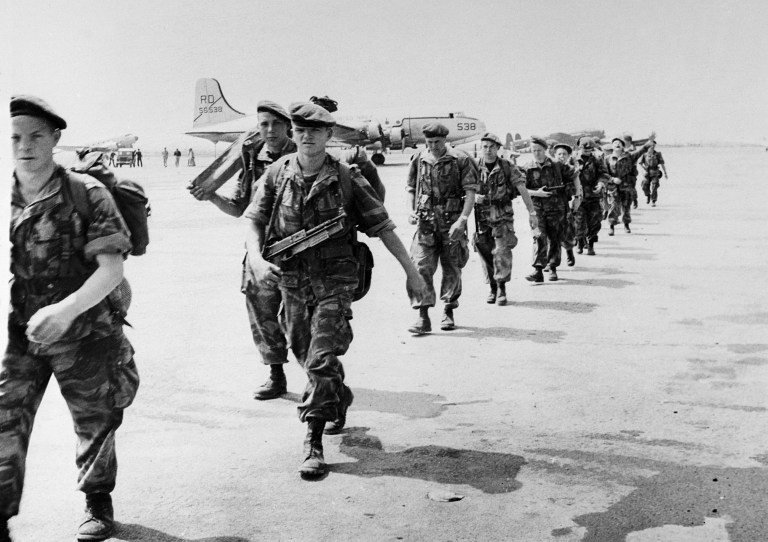The Swiss story of the French Foreign Legion

Enlisted in the French Foreign Legion, thousands of Swiss fought in France’s colonial wars in Vietnam and Algeria. In a new documentary by Daniel Künzi, It Was War, former soldiers tell their stories about how it was.
Among the soldiers who make an appearance are three international stars: Laurel & Hardy and Fernandel. They appear in two scenes taken from famous fictional stories: the Anglo-American duo in the film Beau Hunks and the French actor in One of the Legion. The three comic actors give Künzi’s documentary a more ironic tone.
“I saw truckloads of films about the legion and there was not one with a critical view. All of them glorified the organisation,” Künzi says.
Spearhead of the French Army, the legion was created in 1831 and counted among its ranks many foreigners. Most came from poor or disadvantaged backgrounds and found refuge in the heart of the military. Künzi’s documentary focuses on the Swiss recruited to fight during the colonial wars in Vietnam (1946-54) and Algeria (1954-62).
“These two massive conflicts called for thousands of men,” points out Künzi. “Of course there were other campaigns in which the legion was involved throughout the world, and which Swiss participated in, such as the Suez Canal crisis in 1956. But it was in Vietnam and Algeria that Swiss soldiers were the most numerous, with between 7,000 and 8,000 men.”
The director tracked down six of them who tell their stories in the documentary. Many talk of having had difficult childhoods and say lack of affection or money helped push them into joining the legion.
“Young men who crossed the border into France and were arrested by French police were given two options: repatriation, or join the legion,” says Künzi, adding that the Swiss authorities also played their part. “Lady Helvetia spat out the children from poor families for whom she offered no future.”
Disadvantaged, most of these young men chose the French Army, which also often approached the remand centre in Tessenberg (canton Bern) to enlist soldiers from its resident delinquents.
“They locked up boys who had stolen two or three chickens just to eat,” says Künzi, who, not without difficulty, managed to film the centre. “I had a lot of trouble getting an authorisation to do a report for my film. It was only slightly easier than gaining access to the archives of the legion in Aubagne [southern France]. I tried, but without any luck. As for the French national archives, they are incomplete when it comes to the legionnaires.”
On the right side?
It is difficult to know the exact number of Swiss who enlisted in the legion since the beginning of the 19th century. German historian Peter Huber, who appears in the film, has estimated that around 7,000 to 8,000 participated in the Vietnam and Algeria wars. What is known is that a good number of these soldiers were tortured or killed, a fact some allude to in the film.
“Getting to them to give details was a waste of time, though,” remarks Künzi, who remains surprised that these soldiers were never bothered by the Swiss military police upon their return from Vietnam or Algeria.
“In the eyes of the Swiss authorities, they were fighting for the right side. The side of NATO, which supported France in its fight against communism in Vietnam and in Algeria,” says Künzi.
“It’s outrageous, especially when you consider that the Swiss who just a few years earlier had joined the Free French Army [formed by de Gaulle in 1940 to fight Nazi Germany] were treated much more harshly by Swiss authorities when they returned home.”
Poet and soldier
Since then, the legion’s makeup has changed substantially.
“Today, the legion employs a lot of Ukrainians, Serbs and Croats in its ranks who have military experience,” says Künzi. “From what I know, there is one Swiss, from Vaud, still enlisted.”
“That said, it is not shameful to be a legionnaire today. You know, the legion has had Swiss celebrities, such as Albert de Tscharner, a high-ranking officer, and three of our greatest writers, Michel Viala, Blaise Cendrars and Friedrich Glauser.”
Recently deceased, Viala, a novelist, appears in the film, and the works of the two others, who died several years ago, speak for them. Cendrars writes about the legion in his novel The Severed Hand, and Glauser in Gourrama. Slightly more serious that Stan, Ollie and Fernandel!
(Translated from French by Sophie Douez)

In compliance with the JTI standards
More: SWI swissinfo.ch certified by the Journalism Trust Initiative







You can find an overview of ongoing debates with our journalists here . Please join us!
If you want to start a conversation about a topic raised in this article or want to report factual errors, email us at english@swissinfo.ch.